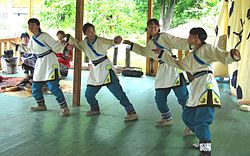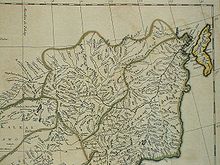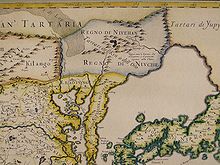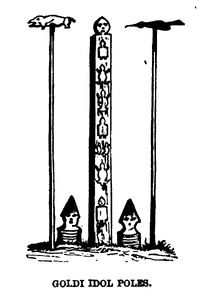- Nanai people
-
Na people
Alternative names:
Hezhen, Nanai, Hezhe;
Golds, Samagir
nanio, nabəi, nanai, kilən, χədʑənNanai children Total population 18,000 (est.) Regions with significant populations Russia, China Heilongjiang  Russia Khabarovsk Krai
Russia Khabarovsk Krai12160 [1]  China Heilongjiang Province
China Heilongjiang Province4245[2]  Ukraine
Ukraine42 [3] Languages Nanai, Mandarin Chinese (in China)
Religion The Nani people (self name нани, Nani means 'natives'; self name Hezhen means 'people of the Orient'; Russian: нанайцы, nanaitsy; Chinese: 赫哲族, Hèzhézú; formerly also known as Golds and Samagir) are a Tungusic people of the Far East, who have traditionally lived along Heilongjiang (Amur), Songhuajiang (Sunggari) and Ussuri rivers on the Middle Amur Basin. The ancestors of the Nanais were the Jurchens of northernmost Manchuria.
The Nanai/Hezhe language belongs to the Manchu-Tungusic branch of the Altai languages.
Contents
Endonyms
Own names are [kilən] ([nanio] and [nabəi]) and [χədʑən] ([nanai]).[4] [na] means native and [nio], [bəi], [nai] means people in different dialects.
The Russian linguist L.I. Sem gives the self-name [xədʑən] in the Cyrillic form, хэǯэ най ( Hezhe nai ) or хэǯэны (Hezheni), and explains it as the self-name of the Nanais of the lower Amur, meaning, "people who live along the lower course of the river".[5] It is the source of the Chinese name for the Nanais, formerly "黑斤" (Heijin), "赫哲哈喇" (Hezhehala), and modern Chinese name "赫哲" (Hezhe).[6]
Traditional lifestyle and culture
Some of the earliest first-hand accounts of the Nanai people in the European languages belong to the French Jesuit geographers travelling on the Ussury and the Amur in 1709. According to them, the native people living on the Ussury and on the Amur above the mouth of the Dondon River (which falls into the Amur between today's Khabarovsk and Komsomolsk-on-Amur) were known as Yupi Tartars (fish-skin tartars, see the Economy section below), while the name of the people living on the Dondon and on the Amur below Dondon was transcribed by the Jesuits into French as Ketching.[7] The latter name may be the French transcription of the reported self-name (see #Endonyms, above) of the Nanais of the lower Amur, [xədʑən], which was also applied to the closely related Ulch people,[8]
According to the Jesuits, the language of the "Yupi" people seemed to occupy an intermediate position between the Manchu language and that of the "Ketching" people; some level of communication between the Yupi and the Ketching was possible.[9]
Economy
As described by early visitors (e.g., Jesuit cartographers on the Ussury River in 1709), the economy of the people living there (who would be classified as Nanai, or possible Udege people, today) was based on fishing. The people would live in villages along the banks of the Ussuri, and would spend their entire summers fishing, eating fresh fish in the summer (particularly appreciating the sturgeon), and drying more fish for eating in winter. Fish would be used as fodder for those few domestic animals they had (which made the flesh of a locally raised pig almost inedible by visitors with European tastes).[10]
The traditional clothing was made out of fish skins. These skins were left to dry. Once dry, they were struck repeatedly with a mallet to leave them completely smooth. Finally they were sewn together.[10] The fish chosen to be used were those weighing more than 50 kilograms.[11] In the past centuries, this distinct practice earned the Nanai the name "Fish-skin Tartars" (Chinese: 鱼皮鞑子, Yupi Dazi). This name has also been applied, more generically, to other aboriginal groups of he lower Sungari and lower Amur basins.[12]
Agriculture entered the Nanai lands only slowly. Practically the only crop grown by the Yupi villagers on the Ussuri River shores in 1709 was some tobacco.[10]
Religion
The Nanais are mainly Shamanist, with a great reverence for the bear (Doonta) and the tiger (Amba). They consider that the shamans have the power to expel bad spirits by means of prayers to the gods. During the centuries they have been worshipers of the spirits of the sun, the moon, the mountains, the water and the trees. According to their beliefs, the land was once flat until great serpents gouged out the river valleys. They consider that all the things of the universe possess their own spirit and that these spirits wander independently throughout the world. In the Nanai religion, inanimate objects were often personified. Fire, for example, was personified as an elderly woman whom the Nanai referred to as Fadzya Mama. Young children were not allowed to run up to the fire, since they might startle Fadzya Mama, and men always were courteous in the presence of a fire.
Nanai shamans, like other Tungusic peoples of the region, had characteristic clothing, consisting of a skirt and jacket; a leather belt with conical metal pendants; mittens with figures of serpents, lizards or frogs; and hats with branching horns or bear, wolf, or fox fur attached to it. Bits of Chinese mirrors were also sometimes incorporated into the costume.
The deceased were normally buried in the ground with the exception of children who died prior to the first birthday; in this case the child's body was wrapped in a cloth or birchbark covering and buried in the tree branches as a "wind burial". Many Nanai are also Tibetan Buddhist.
Modern population
Nanais in Russia
In Russia the Nanais live on the Sea of Okhotsk, on the Amur River, downstream from Khabarovsk, on both sides of Komsomolsk-on-Amur, as well as on the banks of the Ussuri and the Girin rivers (the Samagirs). The Russians formerly called them Goldi, after a Nanai clan name. According to the 2002 census, there were 12,160 Nanais in Russia.
In the Soviet Union, a written standard of the Nanai language (based on Cyrillic alphabet) was created by Valentin Avrorin and others. It is still taught today in 13 schools in Khabarovsk.
Nanais in China
The Nanais are one of the 56 ethnic groups officially recognized by the People's Republic of China where they are known as "Hezhe" (赫哲族 Hèzhé-zú). During the Manchukuo period, the Nanais were practically wiped out in China by the Japanese[citation needed]. They had been confined to prisoner camps and in 1949 they numbered about 300 in China. According to the last census of 2004, they numbered 4,640 in China (mostly in Heilongjiang province). Chinese Nanais speak the Hezhen dialect of Nanai. They also have a rich oral literature known as the Yimakan.[13] The dialect does not have a written system in China and Nanais usually write in Chinese. (Second language literacy is 84%.) However as of 2005 teachers have recently finished compiling probably the first Hezhe language textbook.[14]
Famous Nanais
- Japanese director Akira Kurosawa's 1975 film Dersu Uzala, based on a book by Russian explorer Vladimir Arsenyev, describes the friendship of a Russian explorer and his Nanai guide named Dersu Uzala.
- Nanai female shaman Tchotghtguerele Chalchin performed an incantation recorded in Siberia for the song "The Lighthouse" (an adaptation of the poem "Flannan Isle" by English poet Wilfred Wilson Gibson) on French producer Hector Zazou's 1994 album Chansons des mers froides (Songs from the Cold Seas). Lead vocals were performed by Siouxsie Sioux and background music included performances by the Sakharine Percussion Group and the Sissimut Dance Drummers.
- Kola Beldy (Russian: Кола́ Бельды́) (1929–1993) was a popular singer in the Soviet Union and Russia, particularly known for his rendition of "Увезу тебя я в тундру" (I will take you to the tundra).
- Han Geng, a Chinese pop singer, and a former member of Korean boy band Super Junior.
Autonomous Areas designated for Nanai
Province
(or equivalent)Prefecture level County level Township level Heilongjiang Shuangyashan
双鸭山市Raohe
饶河县Sipai Hezhe Autonomous Township
四排赫哲族乡Jiamusi
佳木斯市Tongjiang
同江市Jiejinkou Hezhe Autonomous Township
街津口赫哲族乡Bacha Hezhe Autonomous Township
八岔赫哲族乡Khabarovsk Krai Nanaysky district References
- Ethnolog on Nanai
- Notes on the Nanai
- [3]
 This article incorporates text from a publication now in the public domain: Chisholm, Hugh, ed (1911). Encyclopædia Britannica (11th ed.). Cambridge University Press.
This article incorporates text from a publication now in the public domain: Chisholm, Hugh, ed (1911). Encyclopædia Britannica (11th ed.). Cambridge University Press.
- ^ Russia Population Census
- ^ The Fourth Population Census of China in 1990
- ^ nationality population
- ^ Ān Jùn 安俊: Hèzhéyǔ jiǎnzhì 赫哲语简志 (Introduction to the Hezhen language; Běijīng 北京, Mínzú chūbǎnshè 民族出版社 1986). Page 1.
- ^ Сем Л. И. (L.I. Sem) "Нанайский язык" (Nanai language), in "Языки мира. Монгольские языки. Тунгусо-маньчжурские языки. Японский язык. Корейский язык" (Languages of the World: Mongolic languages; Tunguso-Manchurian languages; Japanese language; Korean language). Moscow, Indrik Publishers, 1997. ISBN 5-85759-047-7. Page 174. L.I. Sem gives the self name in Cyrillic, as хэǯэ най or хэǯэны
- ^ Hezhe, Talk about the history of the Chinese ethnics
- ^ Du Halde, Jean-Baptiste (1735). Description géographique, historique, chronologique, politique et physique de l'empire de la Chine et de la Tartarie chinoise. Volume IV. Paris: P.G. Lemercier. p. 7. http://web2.bium.univ-paris5.fr/livanc/?cote=00992x04&do=chapitre. Numerous later editions are available as well, including one on Google Books
- ^ О.П. Суник (O.P. Sunik), "Ульчский язык" (Ulch language), in Languages of the World (1997), p. 248; the Cyrillic spelling used there is хэǯэны.
- ^ Du Halde (1735), p. 12
- ^ a b c Du Halde (1735), pp. 10-12
- ^ Fish-Skin Clothes
- ^ UNESCO RED BOOK ON ENDANGERED LANGUAGES: NORTHEAST ASIA
- ^ [1]
- ^ [2]
External links
- The Nanai National Mentality and World Model by Tatyana Sem
- http://www.imdb.com/title/tt0071411/ "Dersu Uzala" a film by Akira Kurosawa about a Goldi (Nanai) and a Russian Army Officer.
East South Central Southwest North Northeast Northwest Nationwide Undistinguished ethnic groups in China Categories:- Indigenous peoples of North Asia
- Ethnic groups in Russia
- Manchuria
- Tungusic peoples
- Khabarovsk Krai
- Ethnic groups officially recognized by China
Wikimedia Foundation. 2010.





